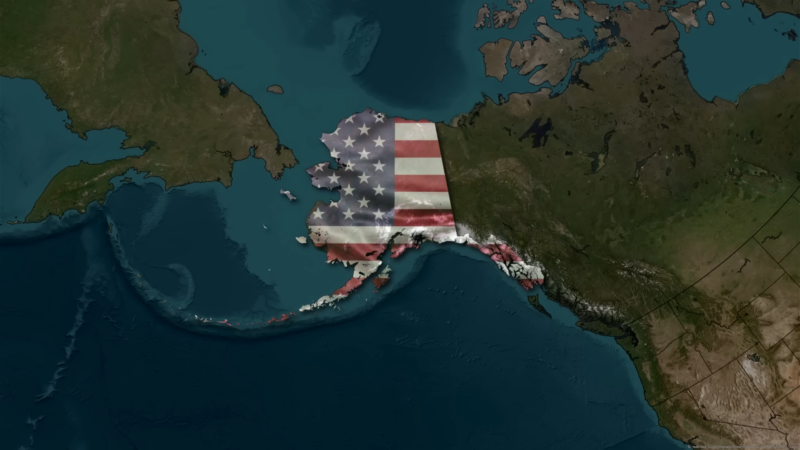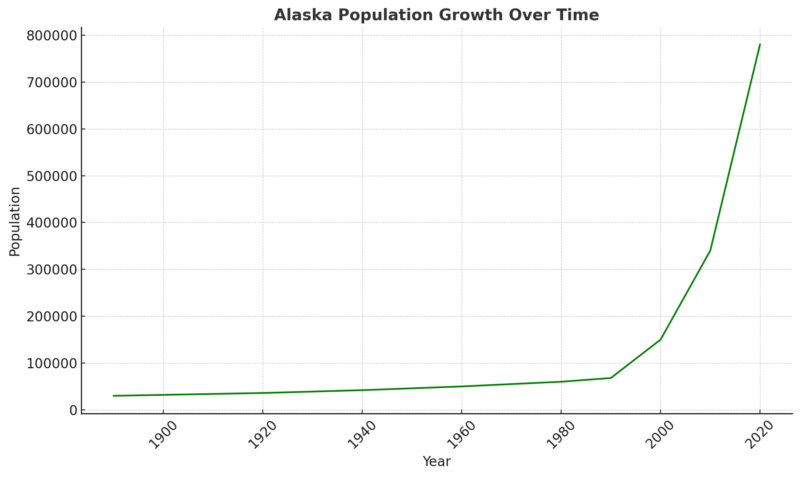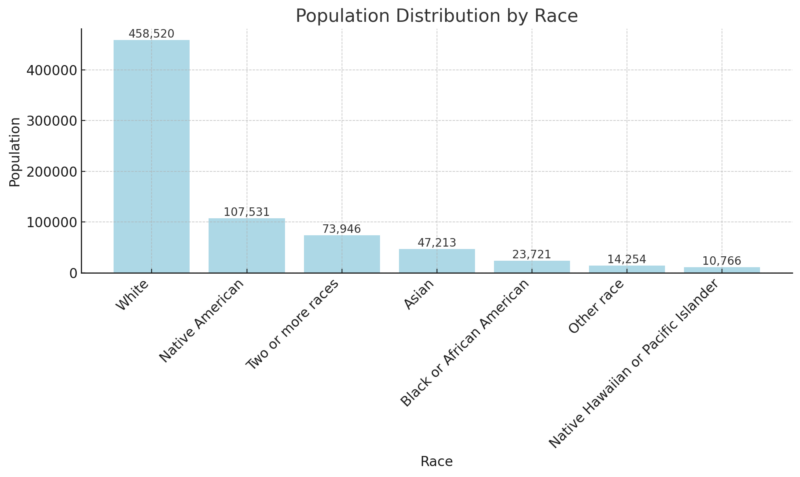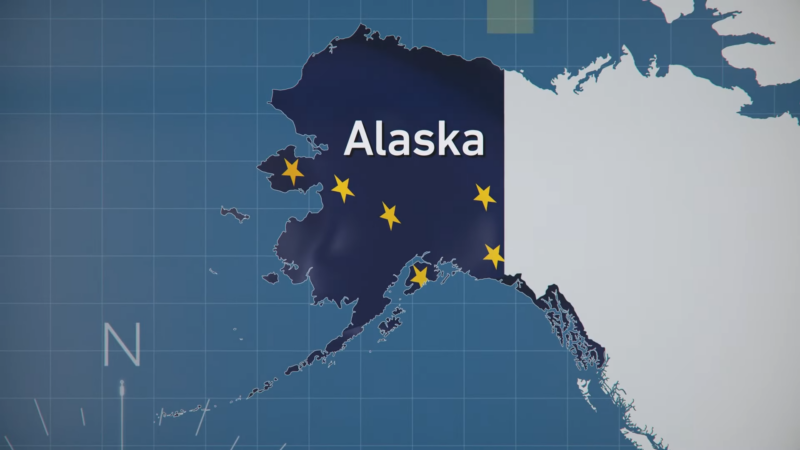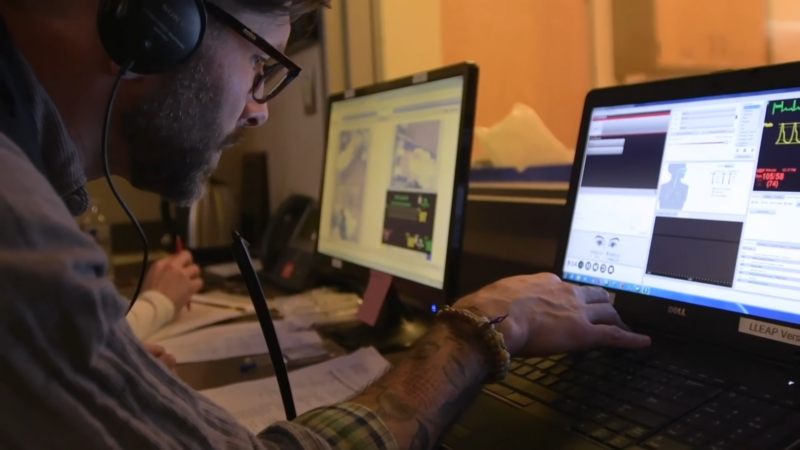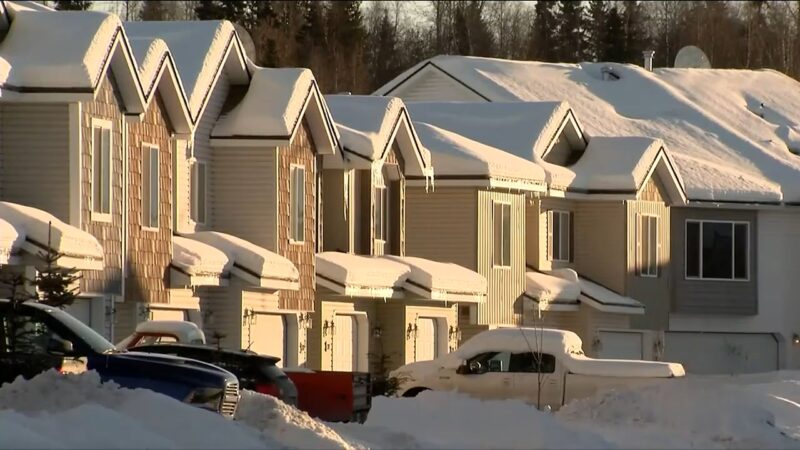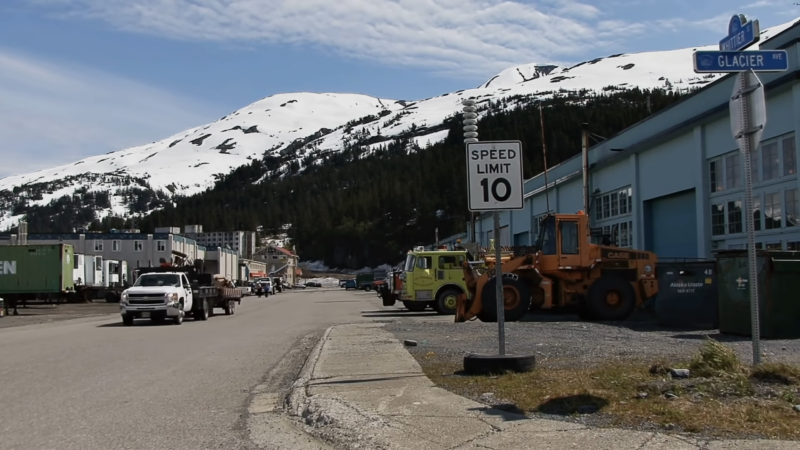Alaska, known for its vast wilderness and stunning landscapes, has seen fluctuating population trends over the years.
In 2025, Alaska population is projected to experience a decline, reversing previous expectations of growth. This shift indicates changes in economic opportunities, climate concerns, and the overall appeal of living in such a remote state.
Recent data reveals that in 2023, Alaska’s population was recorded at 733,536, marking a slight increase from 2022 despite previous declines.
But in 2025 it has risen even more to 741,147 residents.
However, demographers now anticipate a drop, suggesting a differing trajectory in the coming years. These changes have significant implications for local economies, social services, and community planning.
Table of Contents
TogglePopulation Size and Density
A new state population estimate shows Alaska has 741,147 residents, an increase from a figure published last year according to Laborstats. This marks a noticeable shift, as initial forecasts anticipated growth, but recent analyses indicate a potential decline.
Due to its vast territory covering over 663,000 square miles, Alaska retains its low population density. This is further highlighted by the concentration of residents in key areas such as Anchorage and Fairbanks, while remote regions remain sparsely populated.
The sparse population spread contributes to unique challenges, such as delivering services and infrastructure development.
Population By County
| Rank | County | Population |
|---|---|---|
| 1 | Anchorage Municipality | 286,075 |
| 2 | Matanuska-Susitna Borough | 115,239 |
| 3 | Fairbanks North Star Borough | 94,840 |
| 4 | Kenai Peninsula Borough | 61,223 |
| 5 | Juneau City and Borough | 31,555 |
| 6 | Bethel Census Area | 18,224 |
| 7 | Ketchikan Gateway Borough | 13,738 |
| 8 | Kodiak Island Borough | 12,565 |
| 9 | North Slope Borough | 10,603 |
| 10 | Nome Census Area | 9,763 |
| 11 | Sitka City and Borough | 8,282 |
| 12 | Kusilvak Census Area | 8,001 |
| 13 | Northwest Arctic Borough | 7,361 |
| 14 | Southeast Fairbanks Census Area | 7,077 |
| 15 | Chugach Census Area | 6,769 |
| 16 | Prince of Wales-Hyder Census Area | 5,696 |
| 17 | Aleutians West Census Area | 5,160 |
| 18 | Yukon-Koyukuk Census Area | 5,129 |
| 19 | Dillingham Census Area | 4,607 |
| 20 | Aleutians East Borough | 3,461 |
| 21 | Petersburg Borough | 3,427 |
| 22 | Copper River Census Area | 2,674 |
| 23 | Hoonah-Angoon Census Area | 2,262 |
| 24 | Haines Borough | 2,070 |
| 25 | Wrangell City and Borough | 2,064 |
| 26 | Denali Borough | 1,584 |
| 27 | Lake and Peninsula Borough | 1,331 |
| 28 | Skagway Municipality | 1,095 |
| 29 | Bristol Bay Borough | 844 |
| 30 | Yakutat City and Borough | 687 |
Population by Race
The racial composition of this area is presented below in a table for clarity:
According to the 2020 Census, the Alaska Native alone population grew significantly. The population counted 133,311 individuals, marking a 10.9% increase over ten years. The number rises to 241,797 when considering those identifying as Alaska Native alone or in any combination.
Historical Growth Analysis
Historically, Alaska’s population has seen significant fluctuations. From 2000 to 2023, the population increased by 105,658 people as per gov sources. This period demonstrated dynamic changes from growth spurts to times of stagnation or decline.
In 2000, the population was smaller, but by 2010, it had grown by 13.3%, reaching 710,231. This was primarily driven by migration and natural increases. Over the years, certain regions experienced sharper increases, while others remained stable.
Economic Factors for Growth
Alaska LaborStats notes that the economic landscape in 2024 is expected to see modest job growth, primarily fueled by the construction, mining, and oil and gas sectors. The state is projected to add 5,400 jobs, marking a 1.7% increase from the previous year.
This uptick in employment opportunities may contribute to stabilizing population levels and could counterbalance some of the economic challenges the state has faced in recent years.
This growth follows several tough economic years but shows potential for recovery and stability in the job market.
Regional Population Distribution
Alaska’s Department of Labor and Workforce Development website notes that Alaska’s population distribution highlights a significant urban-rural divide, with a large portion of the population concentrated in a few key urban areas. Anchorage, the largest city, serves as the economic and logistical hub of the state, housing about 40% of the total population of Alaska. Specifically, the Anchorage/Mat-Su economic region collectively houses over 403,573 residents as of the latest estimates.
Fairbanks and Juneau also play critical roles as major urban centers. Fairbanks, located in the Interior region, supports an estimated 95,972 residents and serves as a central point for education and military activities. Juneau, as the state capital, has a population of approximately 31,549 and is pivotal for governance and tourism.
In contrast, rural areas in Alaska see much sparser populations, with many communities relying on traditional industries such as fishing and mining. These regions have faced challenges such as population decline due to limited economic opportunities, which contrasts sharply with the growth seen in urban centers.
This regional distribution is crucial for planning and development, as it impacts everything from infrastructure investment to social services, highlighting the need for targeted policies that address the unique needs of both urban and rural populations in Alaska.
Age Structure and Dependency Ratios
| Age Group | Dependency Ratio per 100 working-age (15-64) |
|---|---|
| Youth (0-14) | 30.7 |
| Elderly (65+) | 19.2 |
| Total | 49.9 |
Alaska’s population structure in 2024 showcases a significant young population and a notable percentage of elderly individuals.
The youth dependency ratio is particularly high, indicating a substantial number of children per working-age adult, which underscores the need for robust educational and recreational services.
Conversely, the old-age dependency ratio at 19.2 per 100 working-age persons points to a significant senior population, emphasizing the importance of healthcare and senior services according to Neilsberg.
Together, these ratios suggest that nearly half of the working-age population supports dependents, highlighting the economic and social pressures on the workforce.
The total dependency ratio of 49.9 underscores the necessity for comprehensive planning in healthcare, social services, and infrastructure to address the needs of both young and aging residents effectively. This demographic breakdown provides essential insights for policymakers and community leaders aiming to balance resource allocation with the state’s demographic realities.
Educational Attainment and Workforce Composition
Alaska’s workforce is experiencing shifts influenced by educational attainment. Among individuals aged 25-34, those with a high school diploma showed varying employment rates in recent years. For example, employment rates were 74 percent in 2019, dipped to 68 percent in 2021, and returned to 74 percent in 2023 as per this report.
In Alaska, high school graduation rates vary across different racial groups. US Career Institute notes that white individuals have the highest high school completion rate, reaching 95.99%. When it comes to pursuing further education, they also lead in obtaining bachelor’s degrees, with 37.05% having achieved this level of education.
Other groups show varying educational outcomes. For example, Asian and those identifying as Two or More Races also have significant numbers reaching bachelor’s degree levels.
Meanwhile, the Native American population shows lower bachelor’s degree attainment, though a significant portion complete high school. These statistics highlight the diverse educational landscape present in the state.
| Education Level | Overall Income | Male Income | Female Income |
|---|---|---|---|
| Bachelor’s Degree | $61,748 | $74,516 | $51,955 |
| Graduate Degree | $81,581 | $93,166 | $75,380 |
| High School Graduate | $38,556 | $44,214 | $30,457 |
| Less Than 9th Grade | $26,928 | $29,659 | $22,241 |
| Overall | $50,584 | $57,741 | $41,868 |
| Some College | $48,082 | $57,832 | $38,789 |
This table represents average annual incomes in Alaska based on educational attainment, distinguishing between overall, male, and female incomes.
Alaska Income by Household Type
In 2025, the landscape of household incomes in Alaska shows considerable variation by household type and age of the householder. According to the latest data, the median household income in Alaska stands notably high among those in the age group of 45 to 64 years, reaching around $102,313.
This age group tends to peak in terms of earnings, reflecting accumulated experience and career advancement. Younger householders, particularly those under 25, earn considerably less, with a median income of about $60,279.
The distinction between family and non-family households also plays a significant role in income differences. Family households generally report higher median incomes, around $105,329, compared to non-family households, which have a median income of approximately $57,657. This disparity underlines the economic advantage of combined household incomes that family structures often benefit from according to the article by Neilsberg.
Moreover, the income distribution across the state reflects a moderate level of inequality, as indicated by the Gini coefficient of 0.4278. This suggests that while there is notable income disparity, it is less pronounced than in many other regions.
Health and Social Services Availability
Alaska has taken steps to improve access to health services with recent legislative measures. Expanded access to food stamps and health care was enacted, making Alaska the 43rd state to do so.
This law raises the income threshold for food stamp applicants. It also allows beneficiaries to maintain savings while participating in the program, starting July 2025.
Addressing the nursing shortage remains a high priority. An initiative to recruit out-of-state nurses aims to fill critical vacancies. This shortage has affected healthcare access, driving up costs and putting the senior population at risk.
- Healthcare Spending: In Alaska, significant financial resources are allocated to healthcare, with spending reaching approximately $15,940 per resident in 2020, a figure that underscores the high cost of delivering healthcare services in the state’s unique geographic and demographic context according to USAFacts.
- Health Insurance Coverage: About 23.54% of Alaska’s population is covered by public health insurance plans, such as Medicare, Medicaid, or military healthcare in 2021. This indicates a substantial reliance on government-supported health insurance to make healthcare accessible, especially in rural and remote areas
- Telehealth and Access to Care: The state has expanded telehealth services significantly, aiming to improve access to medical and mental health care across vast and hard-to-reach areas. This is crucial in reducing travel times and ensuring timely medical attention as commonwealthfund stated in their report.
- Public Health Initiatives: Efforts are underway to address various public health challenges through initiatives such as the Healthy Alaskans 2030 plan, which targets significant improvements in health outcomes across the state by focusing on preventive measures and equitable health access
Housing Market and Living Conditions
| Metric | Value | Year-over-Year Change |
|---|---|---|
| Median Sale Price | $367,700 | +2.3% |
| Anchorage Average Price | $449,000 | – |
| Home Sales | 36.3% decrease | – |
| 30-year Mortgage Rates | 6% to 7.1% | – |
| Current Inventory | 2,419 homes | – |
| Sale-to-List Price Ratio | 99.8% | Slightly lower |
In 2024, Alaska’s housing market is marked by a range of dynamics, reflecting a nuanced picture of regional pricing trends, mortgage rates, and market supplies. Redfin says that the median sale price across the state saw a modest increase to $367,700, with Anchorage showing a higher average of $449,000.
However, the market has experienced a significant downturn in home sales, declining by over a third compared to the previous year. This downturn is largely attributed to higher mortgage rates, currently hovering between 6% and 7.1%.
Despite the reduced number of home sales, the Alaska Housing Finance Corporation remains optimistic, focusing on maintaining access to affordable housing and adapting to changing market conditions. This approach underscores a persistent demand for both rental and homeownership opportunities in the state.
The near-perfect sale-to-list price ratio suggests a balance between buyer and seller expectations, although a potential increase in inventory could drive prices down in the near future, reshaping the market dynamics once again.
Renters and Homeowners by Household Category
- All households show an ownership rate of 65.7%, with an average size of 2.72 occupants.
- Married households, characterized by a larger average size of 3.41 people, show a higher ownership rate of 77.5%.
- Non-family units have a relatively balanced division, with 53.8% owner occupancy.
- Female-headed households consist of 52% owners, while male-headed households see 58.2% homeownership.
Future Challenges and Opportunities
Alaska faces several challenges as it navigates population declines over the coming decades. According to the Alaska Economic Development Corporation, the state grapples with a labor shortage and high housing costs, which threaten economic stability.
Despite the challenges, Alaska’s economic forecast features promising prospects. The transportation sector, especially in Anchorage, is expected to experience growth. This sector offers job creation opportunities, potentially attracting new residents to the area. Moreover, investing in sectors like renewable energy could further stimulate economic activity.
Opportunities for Growth
- Transportation: Expansion in this sector might offer new employment opportunities.
- Renewable Energy: Investment here could attract businesses and create jobs.
- Tourism: Emphasizing the state’s natural beauty can boost visitor numbers. Similarly, highlighting the coastal charm and historical landmarks of Rhode Island has proven effective in drawing more tourists to the region. Both locations offer unique experiences that captivate a wide range of travelers.
Addressing these challenges requires strategic planning and investment. Enhancing infrastructure, improving housing affordability, and creating incentives for businesses could mitigate some of these issues. By focusing on these areas, Alaska has the potential to turn its demographic trends into opportunities for sustainable growth.
Alaska’s path forward depends on innovative responses to these evolving dynamics. Active collaboration among government, business, and community leaders will be vital in building a resilient and thriving future for the state, ensuring it remains an attractive place to live and work.
References:
- World Population Review – Alaska Population Projections
- Census Bureau – 2020 Census Data: Alaska Native Population
- Alaska Department of Labor and Workforce Development – Population Projections and Distribution
- Neilsberg – Alaska Population by Age and Dependency Ratios
- Alaska LaborStats – 2024 Job Outlook and Economic Growth
- National Center for Education Statistics – Educational Attainment Report
- US Career Institute – High School Graduation Rates by Race
- Commonwealth Fund – Telehealth and Healthcare Access
- Redfin – Alaska Housing Market Overview
- Alaska Housing Finance Corporation – Affordable Housing Programs
- Alaska Economic Development Corporation – Future Population Challenges
- Healthy Alaskans 2030 – Public Health Initiatives
Related Posts:
- Idaho Population Growth in 2025 - Everything You…
- El Paso Population 2025 - What You Need To Know
- Population Data for Rhode Island 2025 - What You…
- Arkansas’ Population in 2025 - Everything You Need to Know
- Nevada’s Population in 2025 - Everything You Need to Know
- Charlotte Population 2025 - What You Need to Know


